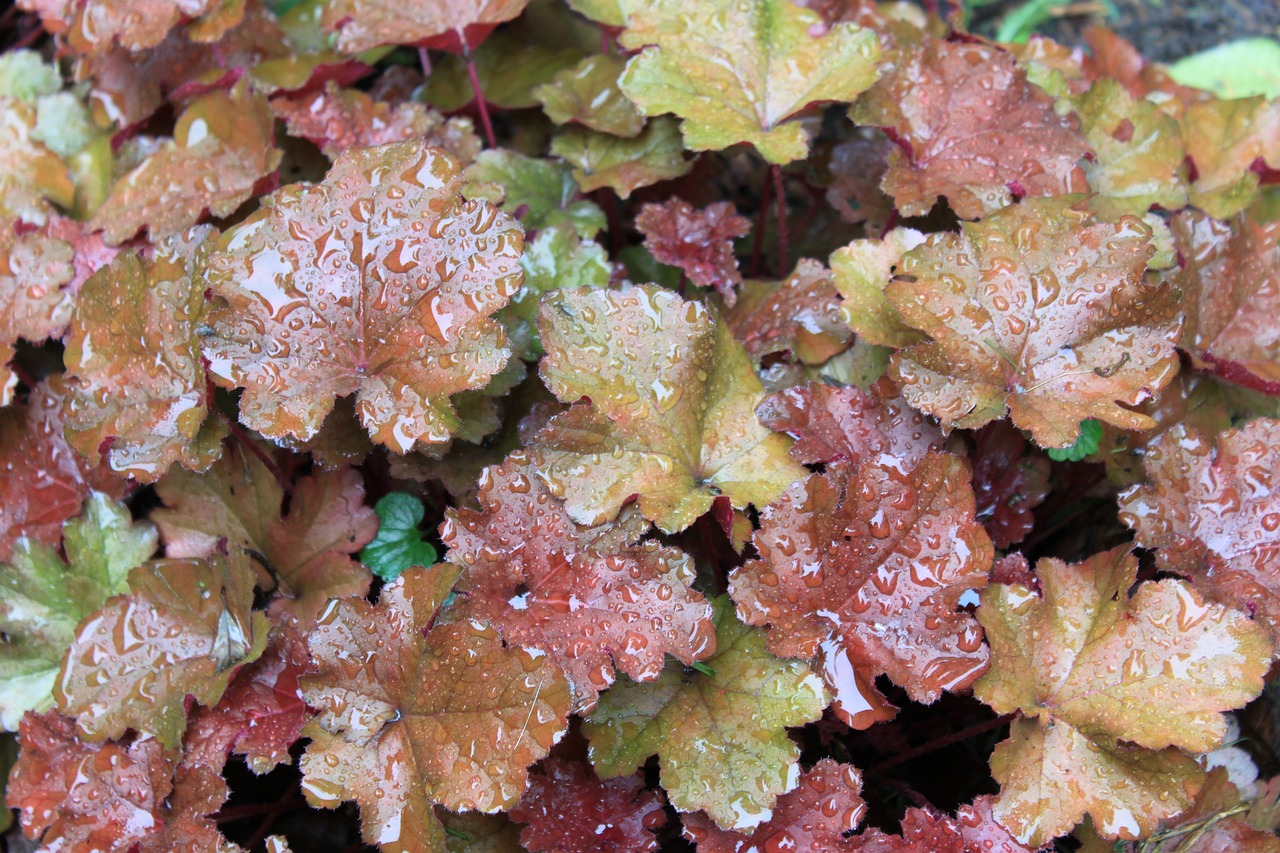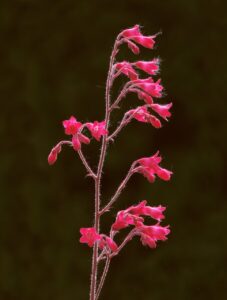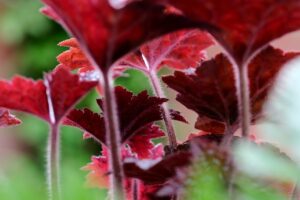Coral Bells (Heuchera)
Overview
Coral Bells, or Heuchera, are a diverse group of perennials treasured for their colorful foliage and dainty bell-shaped flowers. Adaptable and robust, they flourish in various conditions across USDA zones 4-9, offering gardeners a wide palette of leaf shades and a charming summer bloom. Ideal for adding a splash of color and texture to gardens, these carefree plants can enchant in sun or shade and tolerate a range of environmental stresses.

Characteristics
Known for its diverse foliage colors, ease of growth, and showy flowers blooming from June to August.
Region
Found or grown primarily in North America, especially in USDA zones 4-9.
Natural Habitat
Typically found in woodlands, rocky slopes, and mountainous regions.
Cultivation
Prefers full sun to part shade, moderate watering, and can grow in a wide range of soils, including poor soils.
Uses and Benefits
Coral Bells, with their mesmerizing foliage, add a splash of color to any garden, showcasing hues from green to pink and bronze4. Beyond their visual appeal, these plants are practical choices due to their resilience; they withstand a variety of light conditions and are tough against heat, cold, and even drought2. The bonus? Their charming flowers, perfect for cutting, bless gardens with their presence from June to August1.
Whether planted en masse for a foliage-focused display or woven into a mixed border, their easy-going nature makes them a dream companion for gardeners looking to create an effortlessly beautiful and low-maintenance landscape3.

Cultivation Tips
For a thriving bunch of Coral Bells, start by picking a spot that receives full sun to partial shade—a good rule of thumb is morning sunlight with afternoon shade, especially in hotter climates. This balancing act ensures they bask in enough light without getting scorched.
The soil should be well-draining and rich in organic matter. Add compost if you’re working with particularly poor soil; these plants are forgiving but appreciate a nutrient boost. During the growing season, they’ll be quite content with moderate watering. Just make sure not to overwater, as Coral Bells don’t like soggy feet.
Remember, their tolerance to different light conditions and resilience in the face of heat and cold make them incredibly versatile[^1^] 2. For those in USDA zones 4-9, you’ll find these plants to be delightful, low-care additions that bring season-long interest to your garden with their foliage and flowers2.
During bloom time, from June to August, watch for their delicate bell-shaped flowers that attract pollinators and add a sprinkle of charm among the leaves1. By following these simple tips, you can expect your Coral Bells to grow into robust mounds, approximately reaching 1 to 2 feet in height and width1.
Seasonal Considerations
Coral Bells are a delightful sight from June through August, bringing a cascade of greenish-white, sometimes red-tinged, flowers. Their robust constitution allows them to withstand the extremes of heat and cold, accommodating a breadth of seasonal climates1 2.
When the warmth of summer sets in, these flowers become beacons in your garden, showcasing their vibrant foliage and nectar-rich flowers, which appeal to both gardeners and pollinators alike. Even as the seasons shift, Coral Bells stand resilient, brightening gardens with their colorful leaves when other blooms might fade.

Issues and Troubleshooting
Coral Bells are known for being robust and easy to care for, but they are not without issues. Sometimes, leaves may exhibit discoloration or spots, often a sign of fungal infections or pests like aphids. Ensuring good air circulation and avoiding waterlogged soil can help prevent these problems. Furthermore, despite being tolerant of a range of conditions, they can suffer in extreme heat or severe frosts.
To keep these plants looking their best, it’s important to provide some afternoon shade in hot climates and mulch to protect their roots in colder ones. If leaves start to brown or wilt, it could be a clue that your Coral Bells need a bit more attention—perhaps a drink of water during prolonged dry spells or a protective layer when winter hits. By monitoring and adjusting their care as needed, these issues are generally manageable, keeping your Coral Bells flourishing2 3.
History and Folklore
Coral Bells, or Heuchera, carry with them a storied past, shrouded both in the silent growth of wild American woodlands and the careful tending in settlers’ gardens. While the specific threads of folklore directly associated with Heuchera aren’t well-documented, plants in the Saxifragaceae family often symbolize resilience and delicate beauty, possibly hinting at how original cultivators viewed them. These enchanting perennials emerged from a lineage known to charm many with their diverse foliage colors and dainty bloom stalks.
Captured in the imagination of gardeners and nature enthusiasts alike, Coral Bells resonate with a sense of enduring grace, a testament to their persistent allure through the seasons and the years.
References
1. Heuchera americana – Plant Finder – Missouri Botanical Garden, https://www.missouribotanicalgarden.org/PlantFinder/PlantFinderDetails.aspx?kempercode=k460
2. Heuchera – The Ultimate Guide to Growing Coral Bells | Proven Winners, https://www.provenwinners.com/learn/heuchera
3. How to Grow and Care for Coral Bells – The Spruce, https://www.thespruce.com/growing-coral-bells-heuchera-1402032
4. Heuchera – Wikipedia, https://en.wikipedia.org/wiki/Heuchera
5. Heuchera sanguinea – Plant Finder – Missouri Botanical Garden, https://www.missouribotanicalgarden.org/PlantFinder/PlantFinderDetails.aspx?kempercode=d250
Nicolas Duval
Nicolas is a passionate advocate for nature and the art of wildcrafting. His dedication shines through in Wildcraftia, a website he meticulously crafted to serve as a haven for nature enthusiasts worldwide. Driven by a deep appreciation for nature’s connection to humanity, Nicolas embarked on his journey in 2011 with SmokableHerbs, a platform showcasing his love for nature’s bounty. Building upon this foundation, he established Smokably, a thriving online store offering premium herbs and blends to a global audience.
